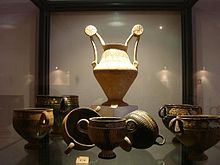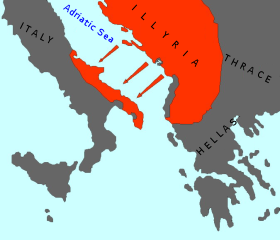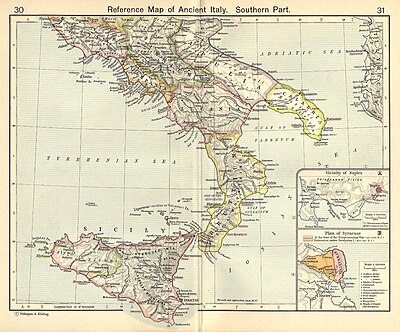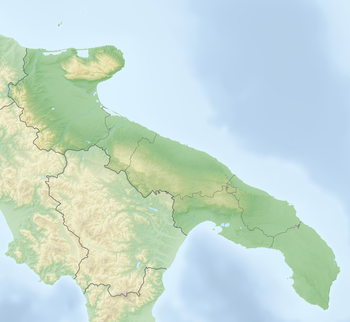
The Messapians were an Iapygian tribe who inhabited Salento in classical antiquity. Two other Iapygian tribes, the Peucetians and the Daunians, inhabited central and northern Apulia respectively. All three tribes spoke the Messapian language, but had developed separate archaeological cultures by the seventh century BC. The Messapians lived in the eponymous region Messapia, which extended from Leuca in the southeast to Kailia and Egnatia in the northwest, covering most of the Salento peninsula. This region includes the Province of Lecce and parts of the provinces of Brindisi and Taranto today.
Starting in the third century BC, Greek and Roman writers distinguished the indigenous population of the Salento peninsula differently. According to Strabo, the names Iapygians, Daunians, Peucetians and Messapians were exclusively Greek and not used by the natives, who divided the Salento in two parts. The southern and Ionian part of the peninsula was the territory of the Salentinoi, ranging from Otranto to Leuca and from Leuca to Manduria. The northern part on the Adriatic belonged to the Kalabroi and extended from Otranto to Egnatia with its hinterland.
After the conquest of the Salento by the Roman Republic in 266 BC the distinction between the Iapygian tribes blurred as they were assimilated into ancient Roman society. Strabo makes it clear that in his time, the end of the first century BC, most people used the names Messapia, Iapygia, Calabria and Salentina interchangeably for the Salento. The name Calabria for the entire peninsula was made official when the Roman emperor Augustus divided Italy in regions and gave the whole region of Apulia the name Regio II Apulia et Calabria. Archaeology still follows the original Greek tripartite division of tribes based on the archaeological evidence.
Name
The names Messapii (Ancient Greek: Μεσσάπιοι) and Messapia are usually interpreted as "(the place) Amid waters", Mess- from Proto-Indo-European *medhyo-, "middle" (cf. Albanian mes-, "middle") (cf. Ancient Greek μέσος méssos "middle"), and -apia from Proto-Indo-European *ap-, "water" (cf. another toponym, Salapia, "salt water"). As Strabo writes, this is the name (exonym) which the Tarentine Greeks used to refer collectively to the Iapygian communities which referred to themselves as Calabri (Ancient Greek: Καλαβροί) and Salentini (Ancient Greek: Σαλεντίνοι) (endonyms) and to their land as Iapygia. The exonym Messapia in Italy corresponds to other toponyms in areas of ancient Greece (e.g. Messapio).
The Messapic tribal name Kalabroi/Calabri has been connected to the Dardanian Galabroi/Galabri in the Balkans.
History
Origins

The origin of the Messapians is uncertain; it is probably due to uncertain and never clearly demonstrated migratory flows of Illyrian or Aegean-Anatolian origin that arrived in Salento on the threshold of the Iron Age around the 9th century BC. The Illyrian hypothesis, today the most accepted by scholars, is supported above all by linguistic considerations.
It is also possible that the Messapians were the result of the fusion between Cretans and, subsequently, Illyrians. According to this hypothesis, the Cretans arrived in Italy in 3300 BC. and the Illyrians would conquer them centuries later.
The Cretan origin was essentially based on tradition and derived from a famous passage by Herodotus on the origins of the Iapygians:
«It is said, in fact, that Minos, who arrived in Sicania (which is now called Sicily) in search of Daedalus, died there by a violent death. After some time had passed, at the incitement of a god, all the Cretans, en masse, except those of Polychne and Praesus, who came with a large fleet to Sicania, besieged the city of Camicus for five years, which, at in my time, it was inhabited by Agrigentines. In the end, however, not being able to conquer it, nor to stay longer to fight against hunger, they would leave, abandoning the camp. When, during the navigation, they found themselves near the coast of Iapygia, a violent storm would have surprised them and slammed them against the land: so, the ships having broken, and no longer seeing any way to return to Crete, the city of Iria was founded in that place. , they remained there and became Iapygians-Messapians (changing their name) rather than Cretans and continentals rather than islanders. From Iria, they say, they founded the other colonies, which the Tarentines long after attempted to destroy, but suffered such a terrible defeat that there then occurred the most serious massacre of Greeks of all those we know of; not only of Tarentines, but also of citizens of Reggio: of the latter, who had come to give aid to the Tarentines forced by Micito son of Chero, 3000 died; the losses of the Tarentines could not even be counted. Micitus, who was from the house of Anassilaus, had been left by him as regent of Rhegium and is the same one who, driven out from Rhegium and settled in Tegea in Arcadia, consecrated the numerous statues in Olympia, which everyone knows.»
— Herodotus - VII, 170
In addition to the Herodothean story, there is the story of the Cretan king Idomeneus, another piece of what we could define as the "Minoan cycle", that is, that literary tradition which sees the ethnogenesis of the Messapian people in the mixing between the Cretan settlers and the local indigenous people Salento. The sallentine humanist Antonio de Ferrariis, referring to the ancient Messapic language, defines it as "the language used by the Sallentines before the coming of Idomeneus", thus using the figure of the latter as a symbol of Greek Salento of which he himself boasted belonging. This additional version to the Herodotean one regarding the Cretan origin of the Messapians is provided by Marcus Terentius Varro from Rieti (116 BC – 27 BC). In fact, the Latin author tells of how the monarch Idomeneus, expelled from Crete following a civil uprising, had sought refuge together with his army in the Illyrian kingdom of King Divitius. From here, joining a further army generously offered by the Illyrian monarch, to which was added a large group of Locrian refugees, he set sail for Salento and settled there, displacing his army in twelve cities and thus giving life to the Messapic dodecapolis. The Cretan, Illyrian and Locrian refugees led by King Idomeneus, who became permanent inhabitants of the Salento districts, would finally collectively recognize themselves with the ethnonym of "Sallentines", since they had made friends "in salo", at sea".
The oldest findings were made in archaeological excavations in some caves near Otranto and Roca; the first stable settlements were identified in the cities of Oria, Cavallino, Vaste and Muro Leccese and can be dated back to the 8th century BC).
Around the 7th-6th century BC. we move from constructions in huts with a plinth in irregular stones, elevation in raw bricks (clay and straw) and roofing with intertwined branches (one was rebuilt in Vaste for educational purposes) to constructions with multiple rooms, quadrangular in shape, with low walls dry stone and brick and tile roofing.
The pre-Italic settlement of Gnatia was founded in the fifteenth century BC during the Bronze Age. It was captured and settled by the Iapyges, as they occupied large tracts of territory in Apulia. The Messapii developed a distinct identity from the Iapyges. Rudiae was first settled from the late ninth or early eighth centuries BC. In the late sixth century BC, it developed into a much more important settlement. It flourished under the Messapii, but after their defeat by Rome it dwindled and became a small village. The nearby Lupiae (Lecce) flourished at its expense. The Messapi did not have a centralised form of government. Their towns were independent city-states. They had trade relationships with the Greek cities of Magna Graecia.
Conflict with Taras
In 473 BC, the Greek city of Tarentum (which was on the border with Messapia) and its ally, Rhegion, tried to seize some of the towns of the Messapii and Peucetii. However, the Iapyge tribes defeated them thanks to the superiority of their cavalry. The war against Tarentum continued until 467 BC.
During the Second Peloponnesian War between Athens and Sparta, the Mesapii were allies of Athens. They provided archers for Athens' massive expeditionary force sent to attack Syracuse in Sicily (415–13 BC). The expedition was a disaster and the entire force was destroyed.
In 356 BC, an alliance between Messapii and Lucani led to the conquest of Heraclea and Matapontus. In 342 BC, Tarentum called for the aid of Archidamus III of Sparta. Archidamus died in battle under the walls of the Messapian city of Manduria in 338 BC.
In 333 BC, Tarentum called Alexander I of Epirus to help them in their war with their Lucani. Alexander defeated the Messapii. He died in a battle against the Lucani in 330 BC.
After the campaign of Alexander I, the Messapii switched allegiance. They allied with Tarentum and Cleonymus of Sparta, who campaigned in the region in 303–02 BC to help Tarentum against, again, the Lucani.
Conquest by the Roman Republic

During the Second Samnite War (327–304 BC) between Rome and the Samnites, the Messapii, Iapyges and Peucetii sided with the Samnites. Some of the cities of the Dauni sided with Rome and some of them sided with the Samnites. The city of Canusium went over to the Romans in 318 BC. Silvium, a Peucetii frontier town, was under Samnite control, but it was captured by Rome in 306 BC.
During the Pyrrhic Wars (280–275 BC), the Messapii sided with Tarentum and Pyrrhus the king of Epirus, in Greece, who landed at Tarentum, ostensibly to help this city in her conflict with the Romans. According to ancient historians, his aim was to conquer Italy. Pyrrhus fought battles against the Romans and a campaign in Sicily. He had to give up the latter and was defeated by the Romans and left Italy. The Messapii were mentioned by Dionysius of Halicarnassus as fighting for Pyrrhus in the Battle of Asculum.
In 272 BC, the Romans captured Tarentum. In 267 BC, Rome conquered the Messapii and Brundisium. This city became Rome's port for sailing to the eastern Mediterranean. Subsequently, the Messapii were rarely mentioned in the historical record. They became Romanised.
During Hannibal's invasion of Italy in the Second Punic War (218–201 BC), the Messapii remained loyal to the Romans. The Battle of Cannae, where Hannibal routed the forces of the Romans and their Italic allies, was fought in the heart of the neighbouring Peucetii territory. The Roman survivors were welcomed into nearby Canusium. Part of the final stages of the war were fought out at Monte Gargano, in the northernmost part of Apulia, in the territory of the Dauni.
Language and writing
The Messapian language is generally considered similar to the Illyrian languages, although this has been debated as a mostly speculative grouping, as Illyrian languages are themselves poorly attested. Albanian dialects are still a relatable group with Messapian, due to toponyms in Apulia, some of towns that have no etymological forms outside Albanian linguistic sources. However, Messapic is to be considered as an independent Indo-European language.
The language became extinct following the Roman conquest of the region, which began during the late 4th century BC. It has been preserved in about 300 inscriptions written in the Greek alphabet and dating from the 6th to the 1st century BC.
Geography
Messapia was relatively urbanized and more densely populated compared to the rest of Iapygia. It possessed 26–28 walled settlements, while the remainder of Iapygia had 30–35 more dispersed walled settlements. The Messapian population has been estimated at 120,000 to 145,000 people before the Roman conquest. The main Messapic cities included:
- Alytia (Alezio)
- Brundisium/Brentesion (Brindisi)
- Cavallino
- Hodrum/Idruntum (Otranto)
- Hyria/Orria (Oria)
- Kaìlia (Ceglie Messapica)
- Manduria
- Mesania (Mesagne)
- Neriton (Nardò)
- Rudiae (outside Lecce)
- Mios/Myron (Muro Leccese)
- Thuria Sallentina (Roca Vecchia)
- Uzentum (Ugento)
Other Messapic settlements have been discovered near Francavilla Fontana, San Vito dei Normanni and in Vaste (Poggiardo).

See also
Footnotes
- Carpenter, Lynch & Robinson 2014, p. 2, 18 and 38.
- Carpenter, Lynch & Robinson 2014, p. 38–39.
- Carpenter, Lynch & Robinson 2014, p. 46.
- Strabo 1924, 6.3.5.
- Colafemmina 2012, p. 1.
- Carpenter, Lynch & Robinson 2014, p. 40.
- Matzinger 2014, pp. 1–2.
- Marchesini 2020, p. 496.
- Baliu 2012, p. 68.
- Maggiulli, Sull'origine dei Messapi, 1934; D’Andria, Messapi e Peuceti, 1988; I Messapi, Taranto 1991
- Maggiulli, Sull'origine dei Messapi, 1934; D'Andria, Messapi e Peuceti, 1988; I Messapi, Taranto 1991
- Francisco Villar, Gli Indoeuropei e le origini dell'Europa, pp. 363-371.
-
Non mi vergogno punto di propalare l’origine de’ nostri Maggiori. Siam Greci ed ognuno lo si deve a gloria recare. Platone il Dio de’ filosofi costumava sovente di ringraziare i Numi per queste tre cose: che Uomo e non bruto, che Maschio, e non Donna, che Greco e non barbaro fusse nato, e cresciuto. Il suo servidore, Eccellenza, che la Giapiggia descrive non da’ Mauri, non dalli Ethiopi, non dalli Allobrogi, o Sicambri, ma dalla Greca Nazione sorge, e deriva. Il Progenitore di chi tal dettaglio della Giapiggia li porge, non ignorò il Greco, e molto meno l’idioma Latino. Fù celebre non per valore dell’armi, ma fù difeso, e scortato dall’integrità della vita, e dalla bontà de’ costumi. Mi vergogno, Eccellenza, parlando seco lei senz’Arbitri dirle, come io nell’Italia abbia tratta la mia origine, e derivati i miei natali, sebbene alcuni scrittori posero il suolo Giapiggio fuor dell’Italia.
— Antonio de Ferrariis, Liber de situ Iapygiae - L.Larva, "Messapia, terra tra i due mari". Paolo Pagliaro Editore, Galatina (LE), 2010
- "It is said that the Sallentine nation was formed from three places: Crete, Illyricum, Italy. Idomeneus, driven into exile from the city of Blanda for sedition during the war against the Magnesians, arrived with a large army in Illyricum to king Divitius. Having received another army from him, and united at sea, due to the similarity of their conditions and projects, with a large group of Locrian refugees, he made pacts of friendship with them and moved to Locri. Having been abandoned, for fear of him, the city he occupied it and founded several centers including Iria and the very famous Castrum Minervae. He divided the army into three parts and twelve nations. They were called Sallentines, since they had made friends at sea". Marcus Terentius Varro
- Archeologia dei Messapi, Bari 1989; I Messapi, Taranto 1991.
- Thierry Van Compernolle, 2001, dall'insediamento Iapigio alla città messapica: dieci anni di scavi e ricerche archeologiche a Soleto (LE)
- Herodotus, The Histories, 7. 170
- Diodoro Siculus, Library of History, 16.63
- Arrian of Nicomedia, The Anabasis of Alexander, 3.6
- Diodorus Siculus, The Library of History, 12.4
- Plutarch, Parallel Lives, The life of Pyrrhus, 13.5–6, 15.4–5
- Dionysius of Halicarnassus, Roman Antiquities, 20.1.1–6, 8
- Zonaras, Extracts of History, 8.7
- Florus, Epitome of Roman History, 15
- West 2007, p. 15...To these can be added a larger body of inscriptions from south-east Italy in the Messapic language, which is generally considered to be Illyrian...
- ^ Mallory & Adams 1997, pp. 378f.
- ^ Carpenter, Lynch & Robinson 2014, p. 18.
- Woodard 2008, p. 11...A linking of the two languages, Illyrian and Messapic must however remain a linguistically unverifiable hypothesis..
- Trumper 2018, p. 385: "Overall, the complex of Albanian dialects remains a solid block of the Albanoid group still relatable with Messapic (observed in place naming in Apulia: some towns have no etymon outside Albanoid sources, for example in toponyms such as Manduria)."
- Philip Baldi (2018). The Foundations of Latin. Walter de Gruyter GmbH & Co KG. p. 150. ISBN 9783110892604.
- Fronda, Michael P. (2006). "Livy 9.20 and Early Roman Imperialism in Apulia". Historia: Zeitschrift für Alte Geschichte. 55 (4): 397–417. doi:10.25162/historia-2006-0026. ISSN 0018-2311. JSTOR 4436827. S2CID 159745099.
- Yntema 2008, p. 383.
- ^ Matzinger 2016, p. 20.
References
- Baliu, Begzad (2012). Onomastikë dhe identitet [Onomastics and Identity] (PDF) (in Albanian). Era. ISBN 978-9951-04-071-6.
- Carpenter, T. H.; Lynch, K. M.; Robinson, E. G. D., eds. (2014). The Italic People of Ancient Apulia: New Evidence from Pottery for Workshops, Markets, and Customs. New York City, New York: Cambridge University Press. ISBN 9781139992701.
- Colafemmina, Cesare (2012). The Jews in Calabria. Leiden, The Netherlands: Brill. ISBN 9789004234123.
- Lamboley, Jean-Luc (2002). "Territoire et société chez les Messapiens". Revue belge de Philologie et d'Histoire. 80 (1): 51–72. doi:10.3406/rbph.2002.4605.
- Mallory, James P.; Adams, Douglas Q., eds. (1997), Encyclopedia of Indo-European Culture, London: Routledge, ISBN 978-1-884964-98-5, (EIEC)
- Marchesini, Simona (2020). "Messapico". Palaeohispanica (in Italian) (20): 495–530. doi:10.36707/palaeohispanica.v0i20.378. ISSN 1578-5386.
- Matzinger, Joachim (2014), Einführung ins Messapische (in German), Vienna
{{citation}}: CS1 maint: location missing publisher (link) - Matzinger, Joachim (2016). Die Altbalkanischen Sprachen (PDF) (Thesis). Ludwig-Maximilians-Universität München - Fakultät Albanologie.
- Trumper, John (2018). "Some Celto-Albanian isoglosses and their implications". In Grimaldi, Mirko; Lai, Rosangela; Franco, Ludovico; Baldi, Benedetta (eds.). Structuring Variation in Romance Linguistics and Beyond: In Honour of Leonardo M. Savoia. John Benjamins Publishing Company. p. 385. ISBN 9789027263179.
- West, Morris L. (2007). Indo-European Poetry and Myth. Oxford University Press. ISBN 978-0199280759.
- Woodard, Roger D. (2008). The Ancient Languages of Europe. Cambridge University Press. ISBN 978-1-139-46932-6.
- Yntema, Douwe (2008). "Polybius and the Field Survey Evidence of Apulia". In de Ligt, Luuk; Northwood, Simon (eds.). People, Land, and Politics: Demographic Developments and the Transformation of Roman Italy, 300 BC–AD 14. Leiden, The Netherlands: Brill. ISBN 9789047424499.
Primary
- Strabo (1924). Jones, H. L. (ed.). Geography. Vol. 3. Cambridge, Massachusetts: Harvard University Press. ISBN 9780674992016.
Further reading
- van Dijk, Willemijn (2010). "Tribale tradities en de beleving van het verleden Messapische cultusplaatsen in de 6de tot 3de eeuw voor Christus". Tijdschrift voor Mediterrane Archeologie (in Dutch). 22 (43): 8–13.
- D'Andria, Francesco. "Greci ed indigeni in Iapigia". In: Modes de contacts et processus de transformation dans les sociétés anciennes. Actes du colloque de Cortone (24-30 mai 1981) Rome : École Française de Rome, 1983. pp. 287–297. (Publications de l'École française de Rome, 67)
- Lamboley, Jean-Luc (1982). "Les hypogées indigènes apuliens". Mélanges de l'École française de Rome: Antiquité (in French). 94 (1): 91–148. doi:10.3406/mefr.1982.1317.
- Lamboley, Jean-Luc (1996). Recherches sur les Messapiens, IVe-IIe siècle avant J.-C. Bibliothèque des Écoles françaises d'Athènes et de Rome (in French). Vol. 292. Rome: Ecole française de Rome. doi:10.3406/befar.1996.1263. ISBN 2-7283-0360-6.
- Lamboley, Jean-Luc (2002). "Territoire et société chez les Messapiens". Revue belge de philologie et d'histoire. Antiquité - Oudheid (in French). 80 (1): 51–72. doi:10.3406/rbph.2002.4605.
- Mastronuzzi, Giovanni & Ciuchini, Paolo. (2011). "Offerings and rituals in a Messapian holy place: Vaste, Piazza Dante (Puglia, Southern Italy)". In: World Archaeology. 43. 676-701.
External links
- Civiltà messapica (in Italian)
| Illyrians | |||||||||||||||||||||
|---|---|---|---|---|---|---|---|---|---|---|---|---|---|---|---|---|---|---|---|---|---|
| |||||||||||||||||||||
| Lists | |||||||||||||||||||||